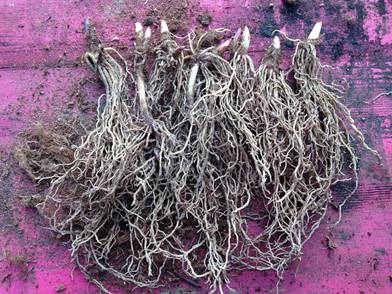From March onwards the greenhouse will start to fill up, but currently it is still and quiet and pretty empty in mine. There is time to make one last winter use of it, before the spring rush begins, and force some lily-of-the-valley pips.
This is something I love to do every few years. The greenhouse is brilliant for forcing bulbs such as miniature irises and dwarf daffodils to bring into the house, and most years I plant some of these in the autumn, so that I have pots to call into the house throughout late winter and early spring, when winter starts to drag. It is such a simple thing to do, depending more on getting your timing right and simply getting around to doing it than on any real skill, and it brings spring forwards. Not that I want to rush winter through, but these little burst of springtime sunshine do help me remember that winter isn’t forever, and that changes are coming, and that is very welcome on a cold rainy February day. Lily-of-the-valley pips are a similar deal, except they are perfect if you forgot to plant your bulbs in autumn and are now wishing you had. Because February and March is the time to plant them.

There is also something a bit special about them, particularly in the house. They have an ethereal quality that sets them quite apart from the forced bulbs. The flowers are waxy and sculptural, pure white and delicately hanging from elegant green stems, and the scent is beautiful. When forced for the house you can really get up close to these beauties.
The time to order them is now, and you will need to look for ‘lily-of-the-valley pips for forcing’. ‘Pips’ are shoots with roots attached – in those plants that are currently in the earth, this is exactly what is now under the ground in this time before growth begins. Those that have been prepared for forcing will have been given an extended chilling time, which convinces them that they have seen the requisite amount of winter, and that spring must now be here.
Plant them into pretty terracotta pots that you will want to bring indoors, with the shoot just below the surface – although the root system is large you can cram them in three to a small pot so that you get a good display, as this pot is only temporary. Water well and leave a pot or two out in the greenhouse, and bring a pot or two straight indoors and onto your kitchen windowsill. They should shoot and start to flower within 3-4 weeks, a deeply satisfying rate of growth, but by keeping some out in the greenhouse and bringing some in, you will stagger this, so that you have blooms over a longer period. I strongly recommend you place them either somewhere they will waft through the house, such as a hall table, or somewhere you will be eye level with them – perhaps near the kitchen sink where they can cheer up washing up time.
After they have finished flowering you can plant them out in the garden where they will grow well in a shady or semi shady spot, but beware – they are strong growers and will gradually colonise whatever area you give them, so they are best planted out in that tricky spot where you haven’t been able to get anything to grow. There they will bloom year after year – a little later when they are not forced, around the beginning of May – and you can cut and enjoy these beautiful blooms.


